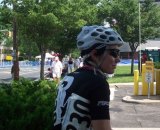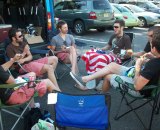
Team Mountain Khakis, taking a break by the river- in the background. You can see the rock skipping competition. © Molly Hurford
I have the best job in the world: when I tell my boss I’ll be late for our weekly phone call because I’m out skipping rocks with a Keough, he tells me to forget the call, but make sure I get pictures. And who can blame him?
There aren’t too many people that can say that they just spent the better part of the week with a horde (or herd) of cyclists living in her basement. Then again, most people probably wouldn’t guess that a group of pro cyclists could spend three hours trying to catapult each other off air mattresses in an attempt to touch the ceiling. I’ve spent plenty of time with my teammates over the past couple of years, but our level of racing (and playing) was always tempered by college and homework. These guys, on the other hand, have one job: to race their bikes as fast as possible. The past week proved to be extremely interesting for me, as I got to experience hanging out and riding with a group of guys who are “living the dream.”
This week, that’s what I’m focusing on: living the dream. It’s not entirely cyclocross-specific, per se, but getting an insider view of the pro life is definitely something that may be of interest for those who dream of pursuing a full-time career as a cyclocross racer. Getting to be a “peripheral pro” for a week, as I would define it, was a whole new experience for someone used to working a solid 80-hour week with minimal time for training. As it turns out, these guys take rest just as seriously as they take training and racing, and they certainly excel at it. So, this week has had me thinking a lot about what it means to be a pro cyclist in the US today, and if it’s something I could ever imagine doing, having witnessed it firsthand from pre-race meetings to the trip to the mall in search of gold chains.
While Team Mountain Khakis is currently in road season, a lot of the racers are also known for their cyclocross skills. I had Luke Keough and Travis Livermon staying with me, while Adam Myerson stayed close by with another friend and teammate. While I was excited to be able to get some interviewing done, I was more excited about the prospect of riding with the crew on their recovery days and seeing how a group of cyclists in their early 20s interacted with each other. Turns out, they’re a lot of fun!
We all raced the Tour of Somerville on Monday, and for those of you who aren’t familiar, it’s one of the oldest bike races in the US, featuring a world-class pro field. I was able to race in the Women’s Pro-1-2-3 field, though I felt pretty intimidated when call-ups included a couple different world champions and recently-interviewed-by-me cyclocross-superstar Laura Van Gilder. This was not a small field! Luckily, despite a distinct lack of road riding lately, I managed to not embarrass myself during the race, finishing with the main pack.
But when the race was over and done with, the really interesting part of the week began. With another race on Thursday night, there were two days for the Mountain Khakis crew to relax and recover. And recover they did!
Want to know how pro cyclists recover from a big race? After sleeping until noon (I was up at six to work), we spent a couple of hours pouring over back issues of Cyclocross Magazine, reading out loud the interview with Luke Keough from three years earlier and making him guess his own answers to the questions. After that, we sojourned on a “leisurely” ride to the Delaware River, where all but one member of the team and I decided to go for a quick swim, still in kit. Competitive as they all are, a rock throwing contest ensued almost immediately. (I’m not at liberty to disclose who won.) After an ice cream recovery snack, we rode home with Luke and Thomas swerving into each other, Luke hopping off-road to display his ’cross skills on a road bike and of course, we endured multiple “attacks” and “breakaways” in the course of the ride. The handling skills these guys have, even when they’re just fooling around, make it apparent why they’re such great racers.
The next day was almost an exact repeat, though I missed chunks of it because, unlike them, I had to go to an office for a few hours. (They went to the “office” too, but for them, work was riding all of the back roads near my house.) Thursday morning during their pre-race easy (for them) ride, Luke came up with a brilliant idea for my cyclocross training. Near my house is a chunk of woods that my family has owned for ages, used in November and April for hunting. It’s roughly a square mile, and wooded enough to be perfect for making a mock cyclocross course to practice on, complete with barriers and other obstacles. I’ll be setting that up in coming weeks, and I plan on posting pictures and, depending on how well my plan for barrier-building goes, posting some DIY advice on that.
Over the course of the week, seeing cyclocross superstars Myerson and Keough interact as team captain to rider showed an entirely new dynamic: on the ’cross course, the two are combatants fighting for the win, but during road season, the two work together. Depending on some outside factors, cyclocross season will be interesting for the two of them, after spending so much time together as a team and learning to work together. (Look for both of them to pop up in our “In the Saddle with…” feature in coming weeks.)
Watching them race was infinitely more stressful than actually racing. On Thursday, they raced in the Basecamp International (NRC) road race, a race with only a Pro/1 field and a lot of tricky corners and crashes. The team had some bad luck (Myerson flatted and Keough flatted twice and broke a wheel), and as the peloton passed by, I would try to count the racers and often would be missing someone because they were behind a crash or in the pit, so I was constantly worried about them crashing – much more so than I typically worry about crashing in my own races!
It’s not all fun and games though: when you’re racing because it’s your job (as opposed to merely “like it’s your job,”) there’s a lot more pressure to perform, and having a bad race is the same as having a bad day at the office, including a boss who wants to know exactly what went wrong, why it went wrong and how you’re planning to fix it. And despite the amount of Reese’s Puffs these guys pack away for breakfast, their lifestyle does require them to maintain the highest possible levels of health to perform the best that they can, which isn’t an easy job when you’re primarily on the road, in hotels or staying in host housing. While these guys may be a blast to hang out with, it’s obvious that they’re constantly thinking about their next race and how to improve their skills. As Luke Keough put it, “When we relax, we have fun. But when we’re racing, we’re really serious about it.”
After a few days of non-stop cycling chatter, mostly about our excitement for the upcoming cyclocross season, I’m ready to get out and start training much more seriously than I have been. And after this week of being “peripherally pro,” would I want their lifestyle? Let’s just say … I wouldn’t turn it down.
If you want to read more about my training, racing and editing exploits, you can find the painfully full version of events here: Molly’s CX Adventures.

























